Theme Parks & Themed Entertainment
Why For did Phase II of Epcot’s World Showcase never get built?
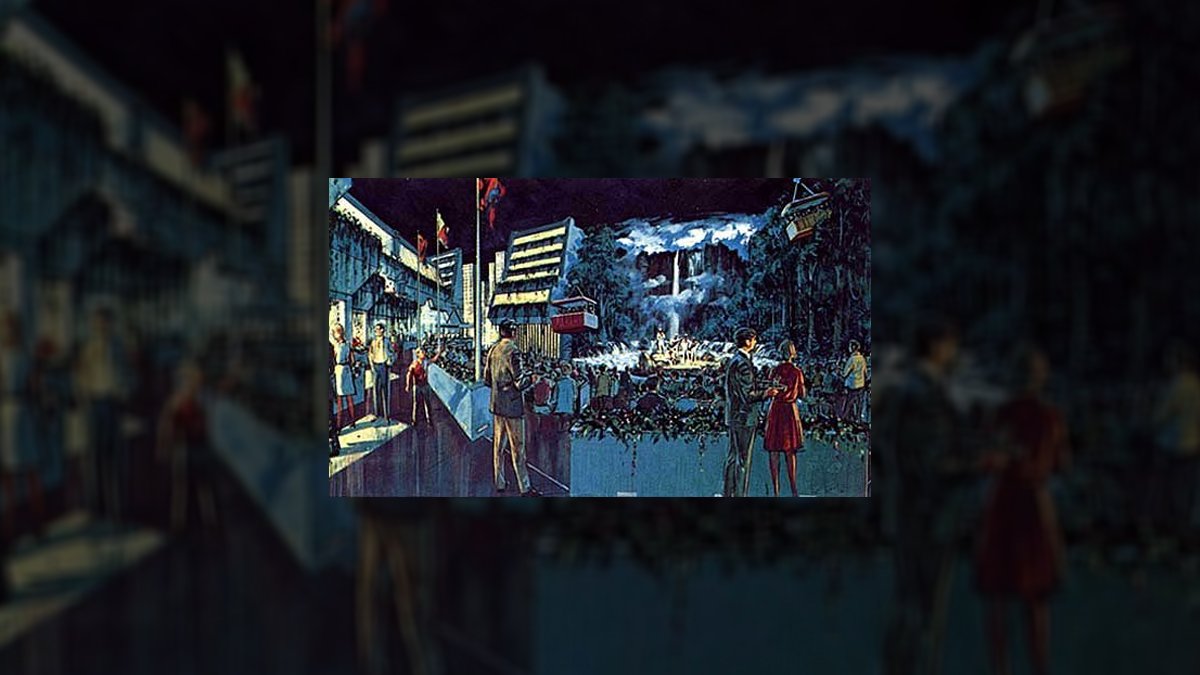
Annoyed in Anaheim writes in to say:
I have to say that I was very disappointed with the Disney
Parks & Resorts presentation at the D23 EXPO. They didn’t announce anything
significant for Walt Disney World. You’d think, given that it’s been almost a
quarter of a century since a new country was last added to the World Showcase,
that they could have at least announced a new international pavilion for Epcot.
Dear Annoyed in Anaheim,
Ah, but just because they announced a new country for Epcot’s
World Showcase area doesn’t mean that Disney will actually ever get around to
building it.
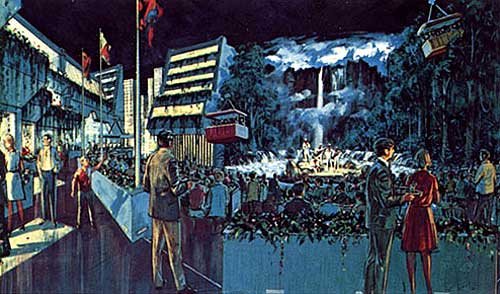
Concept art for the interior of World Showcase’s proposed Venezuela pavilion.
Copyright Disney Enterprises, Inc. All rights reserved
Don’t believe me? Then check out this official press release
that Walt Disney World officials issued on November 10, 1981, which reveals that …
… Venezuela has become the fifth South American country to
join the community of nations in WDW Epcot Center with the signing of a Contract
for Design of a Venezuelan pavilion for Phase II of the World Showcase.
The World Showcase is part of Epcot Center, a showplace for today’s
nations and tomorrow’s technology. Epcot Center will open October 1, 1982 and
will cost $800 million. Gustavo J. Vollmer, Chairman of Consorio Inversionista
Mercantil J Agricola (CIMA) in Caracas and Card Walker, Chairman of the Board
and Chief Executive of Walt Disney Productions signed the preliminary
participation agreement at Walt Disney World.
The Venezuelan pavilion joins a number of countries and
areas of the world scheduled for addition to the eight inaugural World Showcase
nations. They include: Mexico, China, Germany, Italy, Japan, France, the United
Kingdom and Canada. Venezuela, the State of Israel and Equatorial Africa are
among the Phase II pavilions planned.
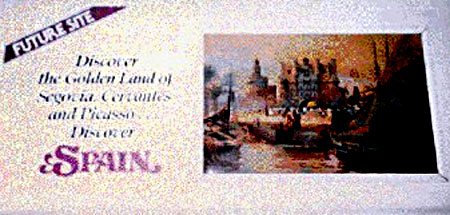
Photograph of the sign that was in place for Epcot’s opening day on October 1,
1982, designating where World Showcase’s Spain pavilion was going to be
built. Copyright Disney Enterprises, Inc. All rights reserved
Better yet, how about this press release from December of
that same year. When Disney World proudly announced that …
Spain (has joined) the growing list of countries in the
community of nations at Epcot Center with the signing of a contract for the
design of a Spain pavilion for Phase II of World Showcase.
D. Aurlio Torrente LaRosa, director of ECCE (Exposiciones
Congresos y Convencione & Espana), on behalf of the Ministry of
Transportation, Tourism and Communications for Spain, and Dick Nunis, president
of Walt Disney World Co. signed the preliminary design agreement.
Nunis also met with King Juan Carlos and Queen Dona Sofia at
the Royal Palace to discuss the scope of the Epcot Center project and Spain’s
participation.
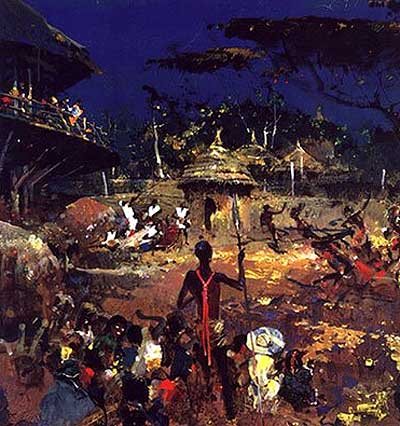
Herbie Ryman’s concept art for World Showcase’s Equatorial Africa
pavilion. Copyright Disney Enterprises, Inc. All rights reserved
Spain joins Venezuela, the State of Israel, and Equatorial
Africa in the Phase II development of World Showcase.
“So why didn’t these Venezuela or Spain pavilions ever get
added to Epcot’s World Showcase area?,” you ask. Well, as Steve Baker (who – at
that time – was director of participant affairs for the Walt Disney World
Resort) told Vicki Vaughn of the Orlando Sentinel in an October 1984 interview:
Efforts to sign on Spain has been tougher. When Baker went to Spain for the
first time in 1981, he succeeded in getting the government to pay for the
design of that country’s pavilion. (He declined to reveal the design costs of individual
pavilions, but he said on average cost about $500,000.) But a new, young
government took over in Spain. “When we came back to talk, we realized that we
had no friends,” Baker said. “So consequently, we had to start over.”
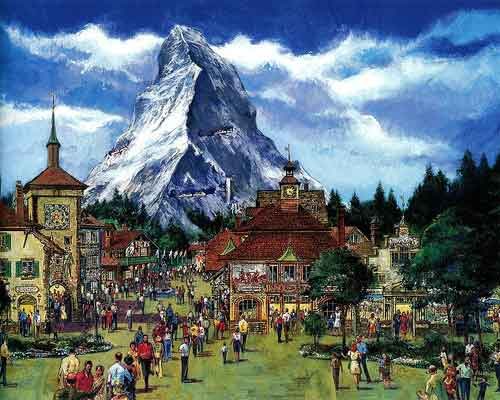
Copyright Disney Enterprises, Inc. All rights reserved
This sort of thing happened over & over again when it
came to luring new nations to come be part of Epcot’s World Showcase area. Take
– for example – the proposed Swiss pavilion (which was to have been the home of
an East Coast version of Disneyland’s very first thrill ride, the Matterhorn
Bobsleds). Disney started negotiations with Swiss officials in 1986, only to
then have these talks broken off in 1987. While these negotiations would eventually
resume in 1989, Mouse House officials were never able to find a Swiss
corporation that was then willing to underwrite the initial construction costs as
well as supply the funds necessary to operate & maintain an attraction of this
size.
“And why were these companies & countries so reluctant
to commit to World Showcase?,” you query. Well, sometimes it was the terms of
the deal (Disney tended to try & get corporations to sign long-term
sponsorship deals when it came to rides, shows and attractions for the Parks.
Take – for example – the 13-year lease that the Mouse got United Technologies
to sign, for the Living Seas pavilion). And sometimes it was the possible
penalties that were involved should a country or company renege on its previous
agreement to sponsor a World Showcase pavilion (EX: The May 1989 lawsuit that the Walt Disney Company
brought against Eskantorp. Which – in December of 1985 — entered into a
preliminary agreement with the Mouse to serve as the principal developer & sponsor
of a South American pavilion. Only to then not be able to come up with the cash
necessary to underwrite the design & construction of this proposed World
Showcase addition).
Of course, sometimes it was just a case of initially
promising negotiations just petering out. Take – for example – the Russia
pavilion. Which was once considered to be a very strong candidate for World
Showcase’s Phase II. Dick Nunis (the then-Chairmain of Walt Disney Parks &
Resorts) personally met with a Russian delegation in November of 1988 and –
after this meeting – sounded very optimistic about this pavilion eventually being
added to Epcot. That said, even though Nunis told the Orlando Sentinel that ” …
the timing is very, very good to have negotiations with the Soviet Union,”
nothing came out of these talks.
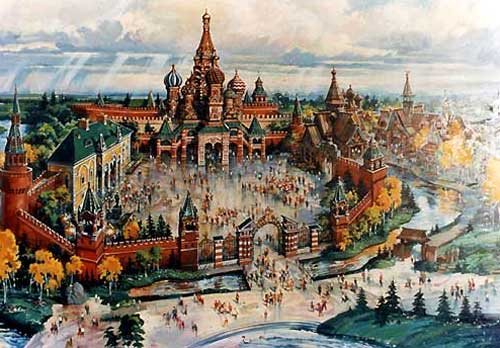
Copyright Disney Enterprises, Inc. All rights reserved
The same sort of thing happened in April 1979, when Walt
Disney Productions officials received a Letter of Intent from Kenyan officials.
Which said that Kenya – along with the nations of Senegal and the Ivory Coast –
had agreed in principal to sponsor World Showcase’s Africa pavilion. But then
this trio of African countries began squabbling about which nation would
receive top billing on the entrance to this sure-to-be Epcot showplace. And
this sponsorship deal quickly fell apart.
Perhaps the saddest story associated with World Showcase’s
proposed Phase II is the one concerning the Israel pavilion. In November 1980,
the State of Israel actually signed a deal to officially become part of Epcot. Joseph
Wollf, special officer to the Minister of Finance and president of the Tourist
Industry Development Corporation signed an agreement that called for this
Middle Eastern country to underwrite the design & construction of a World
Showcase pavilion that was estimated to cost $30 – $35 million. What’s more, Jeshaja
Weinberg (i.e. director of the Jewish Museum in Tel Aviv) agreed to provide
Disney with a wide variety of archaeological artifacts. Which could then be put
on display in a rotating gallery that was to have been part of Epcot’s Israel
pavilion.
“So if the money and the artifacts were already in place,
why didn’t this proposed World Showcase pavilion ever get built?,” you ask.
Well, that’s where things get kind of vague. Though there were signs in place
on Epcot’s opening day trumpeting that the Israel pavilion was “Coming Soon,”
by October 1984, there was no sign of this previously-announced World Showcase
addition.
Steve Baker (while speaking with Vicki Vaughn of the Orlando
Sentinel) tried to put the best possible face on the situation. Insisting that
The Walt Disney Company had …
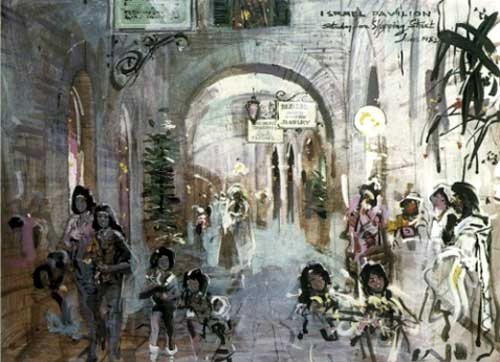
Herbie Ryman’s concept art for the shopping district that was to have been built as part
of the World Showcase’s Israel pavilion. Copyright Disney Enterprises, Inc.
All rights reserved
… made much progress towards an Israel pavilion, getting the
Israeli government to contribute design money and enlisting its help in putting
together private sectors funds, Baker said. But “all this has taken five years
and we expect lots of changes to occur” before the Israel pavilion takes shape.
To date, World Showcase’s Israel pavilion has never made it
off the drawing board. Reportedly because many senior Disney Company officials
believe that including Israel as part of Epcot would then turn this theme park
into a possible target for terrorism. Or – at the very least – a potential
protest focal point. Which actually did prove to be the case when – in 1999 – the
Arab League pushed for a boycott of the Millennium Village at Epcot due to the inclusion
of an Israel Pavilion as part of this 15-month-long celebration.
Trust me, folks. This is just the tip of the iceberg when it
comes to stories associated with the proposed Phase II of World Showcase area.
Which – at one point – was to have included Epcot’s first Eastern European
country, Poland.
Better yet, remind me sometime to talk about the early,
early days of Disney’s World Showcase. We’re talking 1975 – 1977 here. When the
Mouse reached out to representatives of 31 separate countries to ask them to
become part of Epcot … Only to then have each of these countries then say “No.”
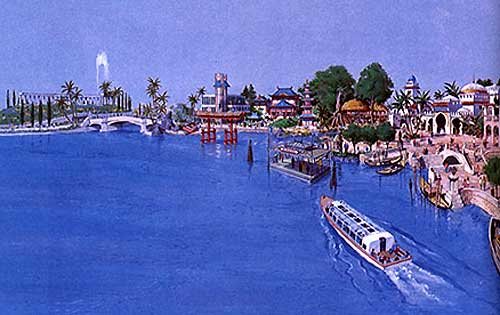
An early concept painting of Epcot’s World Showcase. Back when this part of that
futuristic theme park was supposed to be home to 17 international pavilions.
Copyright Disney Enterprises, Inc. All rights reserved
Seriously. Even the United Kingdom (which was one of the
United States’ closest allies) refused to take part in the project. Reportedly
because they just couldn’t seen the benefit of being part of Disney’s
futuristic theme park. Which is why the Imagineers then quietly revised their
plans for World Showcase. First scaling back the proposed line-up for this
theme park from 31 international pavilions to 17. Then making further cuts,
dropping from 17 to just 8 – 10 countries. And at one point, Disney officials
were having so much trouble lining up World Showcase participants that they
supposedly told Wall Street insiders that – on Epcot’s opening day – this theme
park might only have 5 international pavilions.
But that’s a story for another time. Speaking of which … If
you’d like to see one of your Disney-related questions answered as part of a
future Why For column, please send your queries along to whyfor@jimhillmedia.com.
That’s it for now, folks. And if you live on the East Coast,
here’s hoping that Hurricane Irene doesn’t give you too much trouble this weekend.
Talk to you later, okay?
Television & Shows
The Untold Story of Super Soap Weekend at Disney-MGM Studios: How Daytime TV Took Over the Parks

A long time ago in a galaxy that … Well, to be honest, wasn’t all that far away. This was down in Florida after all. But if you traveled to the WDW Resort, you could then experience “Star Wars Weekends.” Which ran seasonally at Disney’s Hollywood Studios Disney World from 1997 to 2015.
Mind you, what most folks don’t remember is the annual event that effectively plowed the road for “Star Wars Weekends.” Which was “Super Soap Weekend.” That seasonal offering — which allowed ABC soap fans to get up-close with their favorite performers from “All My Children,” “General Hospital,” “One Life to Live” and “Port Charles” — debuted at that same theme park the year previous (1996).
So how did this weekend-long celebration of daytime drama (which drew tens of thousands of people to Orlando every Fall for 15 years straight) come to be?
Michael Eisner’s Daytime TV Origins and a Theme Park Vision
Super Soap Weekend was the brainchild of then-Disney CEO Michael Eisner. His career in media began with short stints at NBC and CBS, but it truly took off in 1964 when he joined ABC as the assistant to Leonard Goldberg, who was the network’s national programming director at the time.
Eisner quickly advanced through the ranks. By 1971, he had become Vice President of Daytime Programming at ABC. That meant he was on the scene when One Life to Live joined the lineup in July 1968 and when All My Children made its debut in January 1970. Even after being promoted to Senior Vice President of Prime Time Programming in 1976, Eisner stayed close to the daytime division and often recruited standout soap talent for ABC’s primetime shows.
Fast forward nearly two decades to July 31, 1995. The Walt Disney Company announced that it would acquire ABC/Cap Cities in a $19 billion deal. Although the acquisition wasn’t finalized until February 1996, Eisner was already thinking ahead. He wanted to use the stars of All My Children, One Life to Live, and General Hospital to draw people to Disney’s theme parks.
He had seen how individual soap stars were drawing huge mall crowds across America since the late 1970s. Now he wanted to bring dozens of them together for something much bigger.
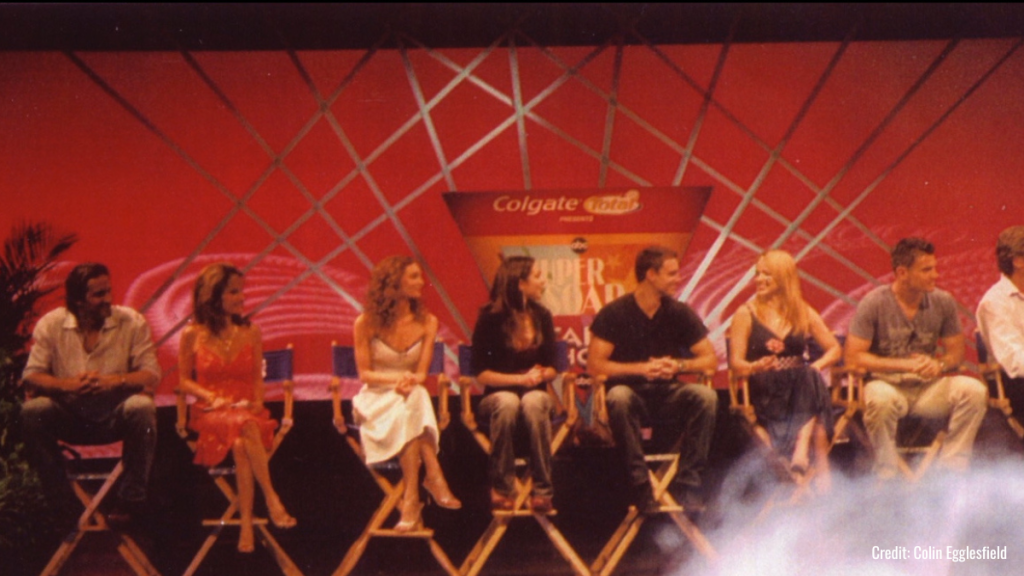
Super Soap Weekend Takes Over Disney-MGM Studios
The very first Super Soap Weekend was announced in June 1996, just a few months after the ABC deal closed. The event was scheduled for October 19 and 20 at Disney-MGM Studios and was a massive success.
The weekend featured panel discussions, autograph sessions, and photo opportunities with the stars of ABC’s daytime dramas. Thousands of fans packed the park for the chance to meet their favorite actors. Due to the overwhelming response, the event became an annual tradition and was eventually moved to Veterans Day weekend each November to better accommodate attendees.
Longtime fans like Nancy Stadler, her mom Mary, and their close friend Angela Ragno returned year after year, making the event a personal tradition and building lifelong memories.




West Coast Events and the ABC Soap Opera Bistro
Disney even tried to recreate the event out west. Two Super Soap Weekends were held at Disneyland Resort, one in April 2002 and another in June 2003.
At Disney’s California Adventure, Eisner also introduced the ABC Soap Opera Bistro, a themed dining experience that opened in February 2001. Guests could dine inside recreated sets from shows like General Hospital and All My Children, including Kelly’s Diner and the Chandler Mansion. The Bistro closed in November 2002, but for fans, it offered a rare opportunity to step into the world of their favorite soaps.
SOAPnet, Port Charles, and the Expansion of Daytime TV at Disney
Eisner’s enthusiasm for soaps extended beyond the parks. In January 2000, he launched SOAPnet, a cable channel dedicated to prime time replays of ABC’s daytime dramas.
During his time at Disney, General Hospital also received a spin-off series titled Port Charles, which aired from June 1997 to October 2003. The show leaned into supernatural plotlines and was another example of Eisner’s commitment to evolving and expanding the soap genre.
The Final Curtain for Super Soap Weekend
In September 2005, Eisner stepped down after 21 years as head of The Walt Disney Company. Bob Iger, who had previously served as President of ABC and Chief Operating Officer of ABC/Cap Cities, took over as CEO. While Iger had deep ABC credentials, he didn’t share Eisner’s passion for daytime television.
In the fall of 2008, Disney hosted the final Super Soap Weekend at what was then still called Disney-MGM Studios. That same year, the park was rebranded as Disney’s Hollywood Studios, and Disney began shifting away from television-focused experiences.
Within the next five years, the rest of Eisner’s soap legacy faded. One Life to Live was canceled in January 2012. SOAPnet was rebranded as Disney Junior in February 2013. Later that year, All My Children ended its 41-year run on ABC.
Only General Hospital remains on the network today, the last standing soap from the golden age of ABC Daytime.
A New Chapter for Daytime TV and Super Soap Fans
The soap genre may have faded from its former glory, but it’s not gone. On February 24, 2025, CBS premiered a brand-new daytime drama called Beyond the Gates, marking the first new soap launch in years.
Meanwhile, All My Children alum Kelly Ripa has been actively working on a revival. In September 2024, she mentioned a holiday-themed movie set in Pine Valley that would bring back many original cast members. The project was in development for Lifetime, though its current status is unclear.
And what about Super Soap? Fans like Nancy and Angela still hope Disney will bring it back. Even if it only featured the cast of General Hospital, it would be a welcome return for longtime viewers who miss that one weekend a year where the magic of Disney collided with the drama of daytime TV.
If you want to hear firsthand what it was like to be part of Super Soap Weekend, be sure to listen to our I Want That Too podcast interview with actor Colin Egglesfield. He shares behind-the-scenes memories from his days as Josh Madden on All My Children and what it meant to be part of one of the most unique fan events in Disney park history.
History
The Super Bowl & Disney: The Untold Story Behind ‘I’m Going to Disneyland!’

One of the highlights of the Super Bowl isn’t just the game itself—it’s the moment when the winning quarterback turns to the camera and exclaims, “I’m going to Disney World!” This now-iconic phrase has been a staple of post-game celebrations for decades. But where did this tradition begin? Surprisingly, it didn’t originate in a stadium but at a dinner table in 1987, in a conversation involving Michael Eisner, George Lucas, and aviation pioneers Dick Rutan and Jeana Yeager.

The Unlikely Beginning of a Marketing Sensation
To understand the origins of this campaign, we have to go back to December 1986, when the Rutan Voyager became the first aircraft to fly around the world without stopping or refueling. Pilots Dick Rutan and Jeana Yeager completed the nine-day journey on December 23, 1986, flying over 26,000 miles before landing at Edwards Air Force Base. Their historic achievement earned them national recognition, and just days later, President Ronald Reagan awarded them the Presidential Citizen Medal at the White House.
Meanwhile, Disney was gearing up for the grand opening of Star Tours at Disneyland, set for January 12, 1987. Following its usual playbook of associating major theme park attractions with real-world pioneers, Disney’s PR team invited astronauts Gordon Cooper and Deke Slayton to the launch event. But in a twist, they also invited Rutan and Yeager, who were still making headlines.

A Dinner Conversation That Changed Advertising Forever
After the Star Tours opening ceremony, a private dinner was held with Disney CEO Michael Eisner, George Lucas, and Eisner’s wife, Jane. During the meal, Eisner asked Rutan and Yeager, “You just made history. You traveled non-stop around the planet on a plane without ever refueling. How are you ever going to top that, career-wise? What are you two gonna do next?”
Without hesitation, Jeana Yeager replied, “Well, after being cramped inside that tiny plane for nine days, I’m just glad to be anywhere else. And even though you folks were nice enough to fly us here, invite us to your party… Well, as soon as we finish eating, I’m gonna go over to the Park and ride some rides. I’m going to Disneyland.”
Jane Eisner immediately recognized the power of Yeager’s statement. On the car ride home, she turned to Michael and said, “That’s a great slogan. I think you should use that to promote the theme parks.” Like many husbands, Michael initially dismissed the idea, but Jane persisted. Eventually, Eisner relented and pitched it to his team.
The Super Bowl Connection
With Super Bowl XXI just around the corner, Disney’s PR team saw an opportunity. The game was set for January 25, 1987, at the Rose Bowl in Pasadena—just miles from Disney Studios. What if they convinced the winning quarterback to say, “I’m going to Disneyland” live on-air?
Disney quickly struck a deal with both quarterbacks—Phil Simms of the New York Giants and John Elway of the Denver Broncos—offering each $75,000 to deliver the line if their team won. Simms led the Giants to victory, making history as the first athlete to say, “I’m going to Disney World!” on national television.
A Marketing Triumph
That year’s Super Bowl had the second-highest viewership in television history, with 87 million people watching Simms say the famous line. The next day, Disney turned the clip into a national commercial, cementing the phrase as a marketing goldmine.
Since then, “I’m going to Disneyland” (or Disney World, depending on the commercial) has been a staple of championship celebrations, spanning the NFL, NBA, and even the Olympics. What started as a casual remark at dinner became one of the most successful advertising campaigns in history.
A Lasting Legacy
Jane Eisner’s keen instinct and Disney’s ability to act quickly on a great idea created a tradition that continues to captivate audiences. The “I’m going to Disneyland” campaign remains a testament to the power of spontaneous inspiration and smart marketing, proving that sometimes, the best ideas come from the most unexpected places.
To learn more about Disney’s ties to the world of sports, check out I Want That Too: A Disney History and Consumer Product Podcast.
Television & Shows
How the Creators of South Park Tricked A-List Celebrities to Roast Universal – “Your Studio & You”
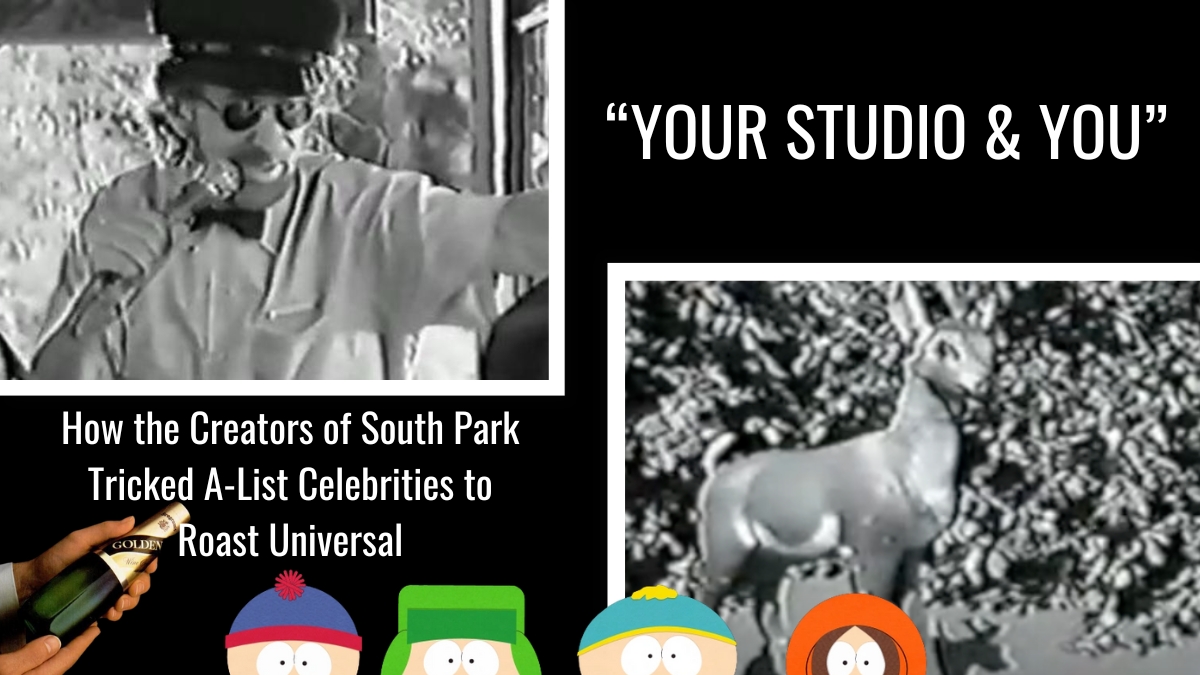
Universal Studios has a rich and storied history, but few moments are as peculiar—and as hilariously cutting—as the creation of Your Studio & You. This 14-minute parody film, commissioned in 1995 to celebrate Universal’s new ownership under Seagram’s, brings together an all-star cast, biting humor, and the unmistakable comedic fingerprints of Matt Stone and Trey Parker.
Long before South Park debuted on Comedy Central in 1997, Stone and Parker were already carving out a reputation for their irreverent style, and Your Studio & You perfectly encapsulates their knack for turning even the most corporate project into something delightfully subversive.
Matt Stone & Trey Parker Before South Park
Stone & Parker were already known out in Hollywood as funny guys. Thanks largely to “The Spirit of Christmas,” which was this video greeting card that they’d crafted for a Fox executive – who then distributed this infamously funny thing (which had Our Lord Jesus Christ & Santa Claus literally duking it out for the holiday affections of Cartman, Kenny, Stan & Kyle) to friends & family.
This was the early 1990s. No internet. Each copy of “The Spirit of Christmas” was made on VHS tape and then mailed. Went viral the old-fashioned way. It’s rumored that George Clooney made over 300 copies of “The Spirit of Christmas” and passed these VHS taps along to friends and family.
Things didn’t move as fast as they do today. “The Spirit of Christmas” still became a sensation out West.
Zucker Brothers
Matt & Trey also had other supporters in the entertainment industry. Among them David Zucker, who was one of the members of ZAZ (i.e., Zucker Abrahams Zucker), the talented trio that made “Airplane!” in 1980, “Top Secret!” in 1984 and the three “Naked Gun” movies.
- The original “Naked Gun” in 1988
- “Naked Gun 2 & 1/2 : The Smell of Fear” in 1991
- and “Naked Gun 33 & a 1/3: The Final Insult” in 1994
All five of these parody films had been made for Paramount Pictures. But in the Late Winter / Early Spring of 1995, Universal had persuaded the Zucker Brothers to come over and set up shop in a bungalow on their lower lot. With the hope that – at some point further on down the line – David & his brother Jerry would start making funny films for Universal.
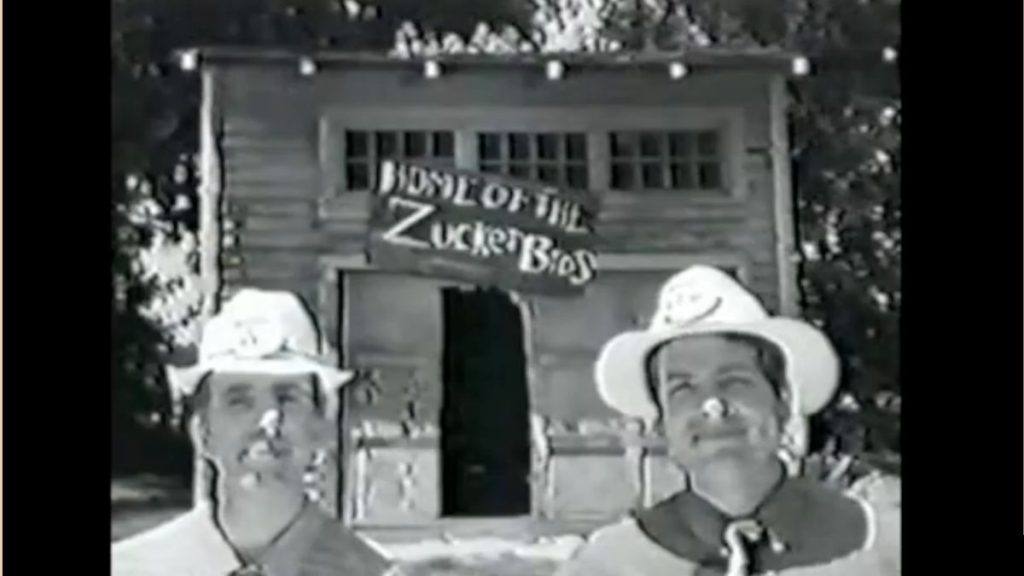
And it’s during this same window of time (We’re now talking April of 1995) that news breaks that Seagrams (Yep, the adult beverage company. Who – at the time – was making an absolute fortune on the sales of wine coolers) was about to buy a majority stake in MCAUniversal. We’re talking control of 80% of that company’s stock. Which would effectively make Seagrams the new owners of Universal Studios.
Edgar Bronfman
And Edgar Bronfman – the owner of Seagrams – knew that Universal had had a tough time with its previous owners – which had been the Matsushita Electric Industrial Co. of Japan. Matsushita had bought MCA back in November of 1990 for $7.5 billion but had never really understood the entertainment industry.
This is why – after repeatedly butting heads with Lew Wasserman & Sidney Sheinberg (i.e., the heads of Universal Studios & the Universal theme park respectively) when it came to creative control of this company – Matsushita decided to wash it hands of the entire enterprise. Agreeing to sell their holdings in MCA to Seagrams for $5.7 billion (effectively taking a nearly $2 billion loss on this investment).
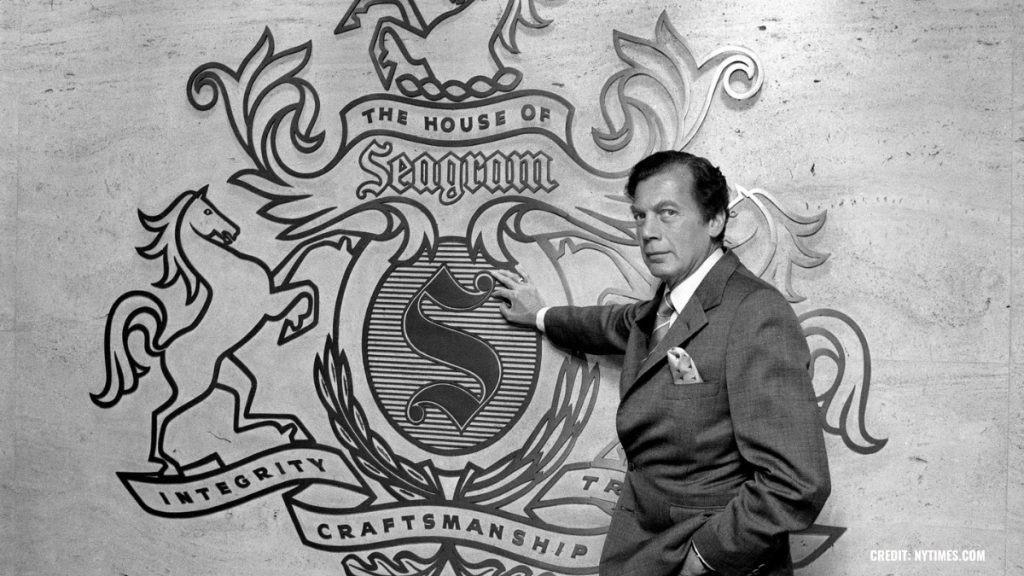
And Bronfman … He knew that some bad feeling had developed between Hollywood’s creative community and the Japanese owners of Universal. The thinking was that executives at Matsushita Electric had just not gotten what it took to make movies & TV shows.
And Edgar? Right from the get-go, he wanted to show that Seagrams was NOT going to be Matsushita Electric Redux. Bronfman was looking for a way to send a clear message to Hollywood’s creative community that Universal’s new owners got it. That they were willing to work with Hollywood to make the best possible movies & TV shows at Universal.
And how did Edgar decide to get this message across? By making a funny movie.
Zucker Commissions Trey Parker for “Your Studio & You”
Mind you, Bronfman himself didn’t make this film. The owner of Seagrams reached out to David Zucker. Who – after initially agreeing to produce this introduction-to-Universal film – then farmed out the production of the actual project to Trey Parker. Who – just two days before shooting was supposed to star on the Universal Lot – persuaded Matt Stone to come help him on this project.
Which brings us to “Your Studio and You.” Which is a parody of an educational film from the 1950s, right down to being shot in black & white and featuring a very generic soundtrack.
Now what’s amazing about watching “Your Studio and You” today is that this 14-minute-long film features some of the biggest names working in Hollywood back in the mid-1990s. We’re talking about people like recent Golden Globe winner Demi Moore, Sylvester Stallone, Michael J. Fox and Angela Lansbury. Not to mention two of the most powerful men in all of Hollywood, Steven Spielberg & Jeffrey Katzenberg.
And what’s especially interesting about watch “Your Studio and You” is that – as you watch these performers go through their paces in this motion pictures (which – most of the time – involves doing some innocuous task while holding a Seagram’s wine cooler) – you often get the feeling that this star is not in on the gag.
So how did Matt & Trey get away with this? Simple. There was never actually a script for “Your Studio and You.”
Filming “Your Studio & You” at Universal Studios Hollywood
Mind you, David Zucker would always insist that there was. Especially when he’d phone up celebrities on the Universal Lot and say “Hey, I’m sending over a couple of college kids later today. They’re working with me on a new parody film. It’s something that we’re doing for the new owners of Universal. I need just a half hour of your time. We’re shooting something special for the party we’ll be holding when the Seagrams people first arrive at the Studio. Absolutely. You’ll definitely get an invite to that party. So can I count on you to help these kids out? Beautiful. They’ll be over there later this morning.”
And then Matt & Trey would show up and say “… Dang, Miss Lansbury. We’re sorry. We must have left our copy of the ‘Your Studio and You’ script back in our office. Which is clear on the other side of the Lot. So – rather than waste your time – why don’t we do this instead? Follow us over to the Psycho House. Where we’re then going to get footage of you painting the front porch on Mother Bates’ house while you say ‘Gosh, with all of the wonderful improvements going on around here, everyone is going to want to work at Universal.’ Oh, and can we also get you to wear this button on the front of your blazer which reads ‘Universal is A-OK’ ? “

And over & over again, the biggest names who were working for Universal at that time took part in the production of “Your Studio & You” because A) David Zucker vouched for Matt Stone & Trey Parker and B) this was something that was being made for the new owners of Universal. And it’s just natural to want to get in good with the new boss.
Steven Spielberg, Jeffery Katzenberg, and Jaws
But no one at Universal anticipated that “Your Studio & You” would wind up being as sharp edged as the finished product turned out to be. I mean, it’s one thing to bite the hand that feeds you. But “Your Studio & You” ? It doesn’t just bite the hand. It takes the hand off at the wrist.
It’s a brutally funny film. With one of the meanest moments reserved for Steven Spielberg, who plays a driver on the Universal Studio Tour who’s trying to persuade a tram full of bored tourists (one of whom is played by Jeffery Katzenberg) that the “Shark Attack” scene down by Jaws Lagoon is actually exciting.
Spielberg actually says lines like “ … Whoa, whoa. What is going on here? Ladies and gentlemen, this never happens. Look out! It’s a shark! Whoa, that is one big scary shark.”

Mind you, as footage of this mechanical shark repeatedly coming up out of the water is shown, “Your Studio & You” ‘s off-screen narrator (who is voiced by Trey Parker says):
“But what about tomorrow? If we don’t keep in step with the times, things that were once neat and thrilling can become old and stupid.”
“Your Studio & You” Reception
This film was supposed to be shown only once at the welcoming party for Seagrams executive on the Universal Lot. And I’m told that – when Edgar Bronfman saw the finished product at that party – he reportedly turned to David Zucker and said “ … That’s a little more mean-spirited that I think it needed to be.”
And with that, “Your Studio & You” was supposed to go back into the Universal vault, never to be seen again. But when “South Park” debuted on Comedy Central in August of 1997 and then became a sensation for its biting humor, there was suddenly a lot of interest in what else Matt & Trey had done. Which is why copies of “The Spirit of Christmas” began to circulate. And – over time – copies of “Your Studio & You” began to bubble up.
Which – as Stone & Parker have repeatedly pointed out – was just not supposed to happen. Largely because none of the celebrities who appeared in “Your Studio & You” had never signed releases for Universal’s legal department. Because – again – this was for a movie that was only going to be shown once at a private function on the Universal Lot.
Matt mentioned (as part of a career retrospective at the Paley Center in LA back in 2000) that “ … they wouldn’t even let us keep a copy of the finished film.”
It’s a funny but brutal movie. And worth taking a look at today especially if you’re a theme park history buff because it shows Universal Studios Hollywood’s “Jurassic Park: The Ride” still under construction on the Lower Lot. That attraction would finally open to the public in June of 1996.
“Your Studio & You” became a lot easier to see after Seagrams sold off its share of Universal to Vivendi in 2000. Copies began propagating online after that. Though Universal Legal will periodically make an effort to get the latest copy of “Your Studio & You” taken off the Internet because – again – none of the performers who appear on camera ever signed the proper releases and/or were paid for their efforts.
That said, if you’re up for a mean-spirited laugh, “Your Studio & You” is well worth 14 minutes of your time. That said, once you watch this thing, be warned:
- You’re immediately going to be thirsty for a Seagram’s wine cooler
- And you’re going to have a sudden desire to go out & buy a porcelain deer.
-

 Theme Parks & Themed Entertainment7 months ago
Theme Parks & Themed Entertainment7 months agoDisney’s Forgotten Halloween Event: The Original Little Monsters on Main Street
-

 Theme Parks & Themed Entertainment8 months ago
Theme Parks & Themed Entertainment8 months agoThe Story of Mickey’s Not-So-Scary Halloween Party: From One Night to a Halloween Family Tradition
-

 Film & Movies8 months ago
Film & Movies8 months agoHow “An American Tail” Led to Disney’s “Hocus Pocus”
-

 Theme Parks & Themed Entertainment6 months ago
Theme Parks & Themed Entertainment6 months agoDisney and Macy’s 90-Year Thanksgiving Day Parade Partnership: From Mickey’s First Balloon to Minnie’s Big Debut
-

 Television & Shows4 months ago
Television & Shows4 months agoHow the Creators of South Park Tricked A-List Celebrities to Roast Universal – “Your Studio & You”
-

 History3 months ago
History3 months agoThe Super Bowl & Disney: The Untold Story Behind ‘I’m Going to Disneyland!’
-

 Podcast4 weeks ago
Podcast4 weeks agoEpic Universal Podcast – Aztec Dancers, Mariachis, Tequila, and Ceremonial Sacrifices?! (Ep. 45)
-

 Television & Shows1 week ago
Television & Shows1 week agoThe Untold Story of Super Soap Weekend at Disney-MGM Studios: How Daytime TV Took Over the Parks






